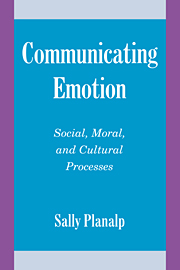Crossref Citations
This Book has been
cited by the following publications. This list is generated based on data provided by Crossref.
Planalp, Sally
1999.
Communicating Emotion: Not Just For Interpersonal Scholars Anymore.
Communication Theory,
Vol. 9,
Issue. 2,
p.
216.
Planalp, Sally
1999.
Communicating Emotion: Not Just For Interpersonal Scholars Anymore.
Communication Theory,
Vol. 9,
Issue. 2,
p.
216.
Kruml, Susan M.
and
Geddes, Deanna
2000.
Exploring the Dimensions of Emotional Labor.
Management Communication Quarterly,
Vol. 14,
Issue. 1,
p.
8.
Burleson, Brant B.
and
Planalp, Sally
2000.
Producing Emotion(al) Messages.
Communication Theory,
Vol. 10,
Issue. 2,
p.
221.
Jasper, James
2001.
Les formes de l’action collective.
p.
135.
Eckstein, Daniel
and
Goldman, Alan
2001.
The Couples’ Gender-Based Communication Questionnaire (CGCQ).
The Family Journal,
Vol. 9,
Issue. 1,
p.
62.
Satterfield, Theresa
2001.
In Search of Value Literacy: Suggestions for the Elicitation of Environmental Values.
Environmental Values,
Vol. 10,
Issue. 3,
p.
331.
Satterfield, Theresa
2001.
In Search of Value Literacy: Suggestions for the Elicitation of Environmental Values.
Environmental Values,
Vol. 10,
Issue. 3,
p.
331.
Baxter, Leslie A.
and
DeGooyer, Dan H.
2001.
Perceived aesthetic characteristics of interpersonal conversations.
Southern Communication Journal,
Vol. 67,
Issue. 1,
p.
1.
Mottet, Timothy P.
and
Beebe, Steven A.
2002.
Relationships between teacher nonverbal immediacy, student emotional response, and perceived student learning.
Communication Research Reports,
Vol. 19,
Issue. 1,
p.
77.
Miller, Katherine
2002.
The Experience of Emotion in the Workplace.
Management Communication Quarterly,
Vol. 15,
Issue. 4,
p.
571.
Berger, Charles R.
2002.
Base-Rate Bingo.
Communication Research,
Vol. 29,
Issue. 2,
p.
99.
Kramer, Michael W.
and
Hess, Jon A.
2002.
Communication Rules for the Display of Emotions in Organizational Settings.
Management Communication Quarterly,
Vol. 16,
Issue. 1,
p.
66.
Cervantes, Christi A.
2002.
Explanatory Emotion Talk in Mexican Immigrant and Mexican American Families.
Hispanic Journal of Behavioral Sciences,
Vol. 24,
Issue. 2,
p.
138.
Broom, Donald M.
2003.
The Evolution of Morality and Religion.
Planalp, Sally
2003.
The Unacknowledged Role of Emotion in Theories of Close Relationships: How Do Theories Feel+.
Communication Theory,
Vol. 13,
Issue. 1,
p.
78.
Zorn, Theodore E.
2003.
The emotionality of information and communication technology implementation.
Journal of Communication Management,
Vol. 7,
Issue. 2,
p.
160.
Kang, Sun-Mee
Shaver, Phillip R.
Sue, Stanley
Min, Kyung-Hwan
and
Jing, Hauibin
2003.
Culture-Specific Patterns in the Prediction of Life Satisfaction: Roles of Emotion, Relationship Quality, and Self-Esteem.
Personality and Social Psychology Bulletin,
Vol. 29,
Issue. 12,
p.
1596.
Knobloch, Leanne K.
and
Solomon, Denise Haunani
2003.
Responses to changes in relational uncertainty within dating relationships: Emotions and communication strategies.
Communication Studies,
Vol. 54,
Issue. 3,
p.
282.
2003.
Language in Social Worlds.
p.
338.



